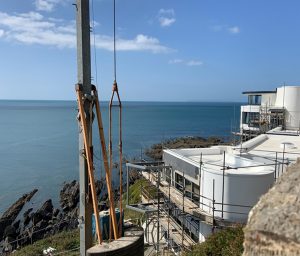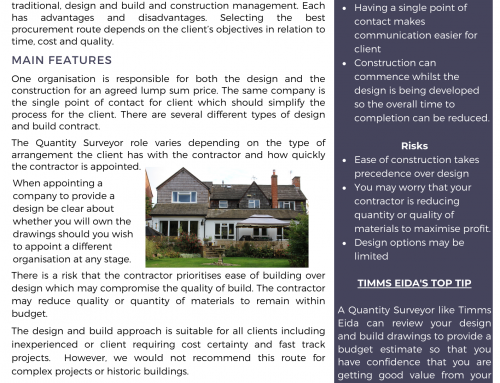Instructing a Quantity Surveyor could help you to avoid your property dream turn into a Grand Design Disaster
Since Channel 4’s property show Grand Designs first aired in 1999 more than 200 episodes have given us a glimpse into the world of home building. Each episode features a property which is architecturally unique or unusual and often the project encounters some delays or variations which result in budget overruns. In spite of the issues, delays and extra costs, the property is usually completed by the end of the episode.
Whilst these construction nightmares make the show entertaining it may well put you off from pursing your own property development dreams. But engaging the services of a quantity surveyor would help your own construction project to run smoothly and avoid many of the most frequently encountered problems.
Chesil Cliff House in North Devon is often identified as Grand Designs worst property disaster. First featured on the show in 2010, the property was revisted in 2019 and is still not finished two years later. During the 2019 episode the property owner revealed that he is more than £4million in debt and that the construction costs are more than double the original estimate.
The still unfinished project was intended to provide a luxury home situated on the side of a cliff with spectacular views along the coast to Saunton Sands and Braunton Burrows in one direction and across Croyde beach to Baggy Point in the other. The finished property was designed to feature a huge circular tower based on a lighthouse design along with a spectacular ‘glass edge’ infinity swimming pool, a home cinema and a sauna and steam room.
An independent chartered quantity surveyor like Timms Eida Associates is engaged in a construction project to take responsibility for helping to estimate costs, quantities and project timelines and providing that information to the clients. A quantity surveyor liaises with the other construction professionals and help to keep the project on track. The earlier a quantity surveyor is instructed the better, and often a client will be referred to a quantity surveyor by their design team. At this stage the quantity surveyor can prepare an outline cost estimate and detailed works schedule.
We have not spoken to the property owner of Chesil Cliff House and we do not know if a quantity surveyor was appointed. From the information we can glean from the TV show and the many articles that have been written about this infamous development, we have identified three problems that may well have been avoided by early instruction of a quantity surveyor.
 Location: The clifftop location was described as ‘dangerous’ for the construction team. The site of the plot on the cliff edge will restrict available work space and is likely to alter the method of working with some construction having to be completed “overhand” (the contractors can only work from the inside of the building). Additional health and safety measures would need to be in place due to the increased risks of working at height. Had we been instructed these extra costs would be identified in our preliminary cost estimate and the method of working would be included in the schedule of works so that allowances could be made in the timetable.
Location: The clifftop location was described as ‘dangerous’ for the construction team. The site of the plot on the cliff edge will restrict available work space and is likely to alter the method of working with some construction having to be completed “overhand” (the contractors can only work from the inside of the building). Additional health and safety measures would need to be in place due to the increased risks of working at height. Had we been instructed these extra costs would be identified in our preliminary cost estimate and the method of working would be included in the schedule of works so that allowances could be made in the timetable.
Foundations and rock structure: The house required complex engineering with 25 ‘anchors’ sunk into the rock in order to support the home. The base rock was blue slate and these works took six months longer than planned and consumed the entire contingency of £200,000. It is likely that the owner did not take specialist advice from engineers earlier enough in the project. With a design of this nature combined with the proposed location we would recommend advice from specialist consultants as soon as possible. Trials to identify the nature of the rock structure should have led to larger contingencies being put in place.
Cash flow: The owners ran out of money and the development was put on hold whilst they sourced alternative funding. Part of our role in a construction project will be to plan cash flow throughout the duration of the project so that the owners could ensure that they had sufficient resources to meet anticipated expenditure. If it had become clear that they would run out of funds we could present various alternatives to enable the project to reach conclusion such as refinancing or a redesign to reduce ongoing costs.
Timms Eida Associates have been successfully appointed on many complex construction projects over many years. We know that the more challenging or unusual a build is the more likely it is that the client will encounter situations where they have to make a decision about extra costs or variations. We provide our clients with the benefit of our years of experience to assist them to find an economic and timely solution to complications as they arise thus avoiding your own Grand Design disaster.







